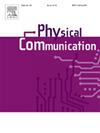Minimizing distortion and enhancing security in Rayleigh fading channels
IF 2
4区 计算机科学
Q3 ENGINEERING, ELECTRICAL & ELECTRONIC
引用次数: 0
Abstract
The trade-off between security, reliability, and distortion in a direct communication link with an eavesdropper is investigated by adjusting both the transmission power and the transmission rate, which affects the distortion size of the distortion-limited coding. This involves encoding data at a predetermined rate with Channel Side Information (CSI) to ensure successful data recovery within a defined distortion threshold. Using higher transmit power and coding rates effectively minimizes average distortion but increases intercept probability, whereas opting for lower transmit power and coding rates reduces interception probability while amplifying signal distortion. Thus, we investigate the distortion-intercept probability trade-off across feasible transmit powers and transmission intervals. For a Rayleigh fading channel, we derived a closed-form expression for the IP and calculated the maximum power when transmitting with a fixed power such that the intercept probability is below a threshold. We also present a water-filling-based power allocation to minimize the average distortion under some intercept probability requirements. With the proposed method, both numerical and Monte Carlo simulation demonstrate that employing a power control strategy reduces the average distortion and intercept probability to 78% and 50%, respectively, showcasing the effectiveness of the approach.
减小瑞利衰落信道失真,提高信道安全性
通过调整传输功率和传输速率来研究在与窃听者的直接通信链路中安全性、可靠性和失真之间的权衡,这影响了失真限制编码的失真大小。这涉及到使用信道侧信息(CSI)以预定速率对数据进行编码,以确保在定义的失真阈值内成功恢复数据。使用较高的发射功率和编码率可以有效地减少平均失真,但会增加截获概率,而选择较低的发射功率和编码率会降低截获概率,同时会放大信号失真。因此,我们研究了在可行发射功率和发射间隔之间的失真-拦截概率权衡。对于瑞利衰落信道,我们推导了IP的封闭表达式,并计算了以固定功率发射时的最大功率,使得拦截概率低于阈值。我们还提出了一种基于充水的功率分配方法,以在某些截距概率要求下最小化平均失真。数值和蒙特卡罗仿真结果表明,采用功率控制策略可将平均失真率和平均截距概率分别降低到78%和50%,证明了该方法的有效性。
本文章由计算机程序翻译,如有差异,请以英文原文为准。
求助全文
约1分钟内获得全文
求助全文
来源期刊

Physical Communication
ENGINEERING, ELECTRICAL & ELECTRONICTELECO-TELECOMMUNICATIONS
CiteScore
5.00
自引率
9.10%
发文量
212
审稿时长
55 days
期刊介绍:
PHYCOM: Physical Communication is an international and archival journal providing complete coverage of all topics of interest to those involved in all aspects of physical layer communications. Theoretical research contributions presenting new techniques, concepts or analyses, applied contributions reporting on experiences and experiments, and tutorials are published.
Topics of interest include but are not limited to:
Physical layer issues of Wireless Local Area Networks, WiMAX, Wireless Mesh Networks, Sensor and Ad Hoc Networks, PCS Systems; Radio access protocols and algorithms for the physical layer; Spread Spectrum Communications; Channel Modeling; Detection and Estimation; Modulation and Coding; Multiplexing and Carrier Techniques; Broadband Wireless Communications; Wireless Personal Communications; Multi-user Detection; Signal Separation and Interference rejection: Multimedia Communications over Wireless; DSP Applications to Wireless Systems; Experimental and Prototype Results; Multiple Access Techniques; Space-time Processing; Synchronization Techniques; Error Control Techniques; Cryptography; Software Radios; Tracking; Resource Allocation and Inference Management; Multi-rate and Multi-carrier Communications; Cross layer Design and Optimization; Propagation and Channel Characterization; OFDM Systems; MIMO Systems; Ultra-Wideband Communications; Cognitive Radio System Architectures; Platforms and Hardware Implementations for the Support of Cognitive, Radio Systems; Cognitive Radio Resource Management and Dynamic Spectrum Sharing.
 求助内容:
求助内容: 应助结果提醒方式:
应助结果提醒方式:


